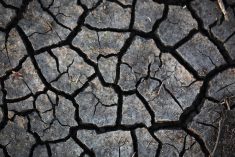Anthony Anyia might be one of the only growers in Alberta who embraced last year’s drought.
The conditions proved ideal for the Alberta Research Council researcher, who was field testing high and low water use efficiency lines of barley and mapping a population that was a cross between the two.
“For us it kind of created the right environment to do the testing,” he said.
Anyia said Canadian barley breeders have produced disease resistant and good malting quality varieties for farmers, but they have struggled to improve yield because of the Prairies’ short and dry growing season.
Read Also

Phosphate prices to remain high
Phosphate prices are expected to remain elevated, according to Mosaic’s president.
Canadian barley yields have remained almost flat over the last two decades and are lower than most other major barley producing countries.
The Alberta Research Council is attempting to buck that trend by creating a tool to help breeders develop varieties that make better use of what little water is available during dry years.
Anyia and his team are attempting to identify genetic markers or pieces of DNA that are associated with three key traits that make some varieties more drought tolerant than others:
The goal is to breed all three traits into new lines to create drought tolerant barley. It is a different tack than that being taken by seed companies, which are spending money to develop genetically modified drought tolerant corn and soybeans.
“The one we are doing here is not genetically modified, so it makes it kind of unique,” Anyia said.
He said the barley industry doesn’t want GM crops because it could disrupt markets.
Anyia and his team are now identifying quantitative trait loci and genetic markers that will help breeders quickly select among their advanced screening material for those traits.
Similar work led to a drought tolerant line of Australian wheat called Drysdale, which delivers 10 to 20 percent more grain than competing varieties during dry years.
Anyia’s team hadn’t analyzed the results from the barley field trials when this story was written, but visual inspection indicated the lines chosen for their high water use efficiency traits showed early vigorous growth with no visible symptoms of drought stress during the hot and dry summer of 2009.
The savings could be significant for prairie farmers if Anyia’s work results in drought tolerant barley varieties that exhibit a similar yield boost as Drysdale.
Anyia said yields of all major crops in Alberta fell by almost 50 percent during the drought of 2002. Losses to barley were estimated at $300 million. A 20 percent yield boost would have cut those losses by $60 million.
“That is lots of money.”
Anyia said his team will turn its attention to another valuable prairie crop if the barley project is successful.
“Once we conclude the barley work, canola is the one we’ll be looking at next.”















